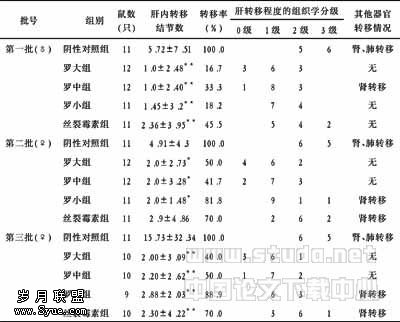胃黏膜肠化生中H.pylori感染与π类谷胱甘肽转移酶表达的相关性
【摘要】 探讨胃黏膜肠化生中幽门螺杆菌(H.pylori)致毒作用与以GST?π为代表的人体对致癌物解毒系统间的相互作用。方法:利用SP法对219例胃黏膜活检组织进行GST?π单克隆抗体的检测;利用HID?ABpH2.5?PAS粘蛋白组织化学技术对171例肠化生黏膜进行分型;利用HE及H.pylori?DNA PCR及ELISA方法对正常胃黏膜和肠化生黏膜进行H.pylori的检测。对80例H.pylori阳性患者进行H.pylori根除。结果:正常胃黏膜未见GST?π的表达,胃癌GST?π阳性率为44.4%。H.pylori阴性组GST?π阳性率高于H.pylori阳性组(P<0.05)。H.pylori根除治疗后,根除组GST?π表达高于未根除组(P<0.05)。肠化生黏膜中GST?π弱阳性或阴性表达如合并H.pylori感染者,胃癌发生的危险性增加。结论:在胃黏膜上皮肠化生阶段H.pylori的致毒作用与GST-π解毒作用彼此相互拮抗。
【关键词】 肠上皮化生;胃癌;幽门螺杆菌
AbstractObjective:To study the relationship between the virulence of H.pylori and human carcinogen detoxification system in the stage of intestinal metaplasia (IM).Methods:About 219 cases were examined in the study, including 30 cases with normal gastric mucosa, 171 cases with IM and 18 cases with gastric cancer. The expression of GST?π were detected by SP method. The types of IM were classified into Ⅰ,Ⅱ,Ⅲ by high?iron diamine /alcian blue pH2.5/periodic acid Schiff (HID?ABpH 2.5?PAS)method:H.pylori infection was confirmed or excluded by hematoxylin?eosin (HE) staining, H.pylori?DNA PCR and enzyme?linked immunosorbent assay (ELISA). Eighty cases with H.pylori infection were received the treatment of H.pylori eradication.Results:The GST?π expression was not found in normal mucosa, the positive rate of GST?π in gastric cancer was 44.4%. The positive rate of GST?π expression in IM without H.pylori infection was higher than that of IM with H.pyloriinfection (P<0.05). The positive rate of GST?π expression in H.pylori eradicated group was significantly higher after H.pylori:eradication than before (P<0.01). The risk of gastric cancer is increased if there was low or no expression of GST?π in H.pylori?infected cases.Conclusion:The carcinogen detoxification role of GST?π and the virulence of H.pylori might interact each other in the stage of IM, which is the precancerous condition of gastric cancer.
Key wordsGST?π;intestinal metaplasia;gastric cancer;helicobacter pylori
谷胱甘肽?S?转移酶(glutathione?S?transferase, GST)是由两个同源二聚体亚基组成的一个多功能超基因家族,依GST同工酶等电点的不同分为碱性α类、中性μ类和酸性π类。近年来,将θ及微粒体GST同工酶与α,μ,π并列为五大类。研究证实,GST是人体重要的Ⅱ相解毒酶[1],是人体内一种重要的保护性物质,具有解毒和抗癌的作用,其中π类谷胱甘肽?S?转移酶(GST?π)的作用大于其它同工酶,与人类肿瘤关系更密切[2]。
胃黏膜肠上皮化生(简称肠化生)是正常胃黏膜受到损伤后转变为肠上皮和腺体的一种病改变。许多研究认为,在这一过程中幽门螺杆菌(Helicobacter pylori,H.pylori)起着重要作用[3,4]。H.pylori对人体是一种损害因素,GST?π是人体内的一种重要的保护性物质,那么H.pylori感染能否造成GST?π表达的改变?本研究就H.pylori感染及根除治疗后对肠化生胃黏膜中GST?π表达的影响进行了观察。
1 材料与方法
1.1 材料
219例胃黏膜活检组织取自辽宁省庄河市胃癌高发区,每例取新鲜胃黏膜5块,95%乙醇固定,石蜡包埋,制成3张5μm切片,进行HE、HID?ABpH2.5?PAS粘蛋白组织化学染色及GST?π免疫组织化学染色。经HE染色正常胃黏膜30例,具有肠化生改变者171例,胃癌18例。
1.2 方法
① HID?ABpH2.5?PAS粘蛋白组织化学染色:依肠化生组织形态及粘液染色的不同将肠化生分为Ⅰ型(完全性)、Ⅱ型(不完全性)、Ⅲ型(不完全性)[5]。本实验171例肠化生中Ⅰ型54例,Ⅱ型76例,Ⅲ型41例。②H.pylori的检测:利用HE、H.pylori-DNA PCR及ELISA检测H.pylori IgG 抗体3种方法,确定有无H.pylori感染。上述2种或3种方法检测为阳性者,判断为H.pylori阳性,否则为阴性。171例肠化生中,109例H.pylori阳性,62例H.pylori阴性。③链霉菌抗生物素蛋白?过氧化酶法(SP)免疫组织化学检查:GST?π单克隆抗体购自北京基因公司,即用型SP试剂盒购于福州迈新公司。严格按说明书操作。按[6]的方法,依着色强度及范围进行综合评分。着色强度:不着色0分,浅黄色1分,棕黄色2分,棕褐色3分。着色范围:无着色为0分,着色小于1/3为1分,着色大于1/3为2分,弥漫着色为3分。将以上两项相加为最后结果,0分为阴性(-),2分为(+),3~4分为(++),5~6分为(+++)。④除菌疗法:80例H.pylori阳性患者按三联疗法常规治疗(铋制剂+阿莫西林+甲硝唑),停药后3个月在原部位取材复查。采用治疗前同样方法进行H.pylori检测,其中H.pylori根除38例,H.pylori未根除42例。对以上标本同样进行HID?ABpH2.5?PAS粘蛋白组织化学染色及GST?π单抗的免疫组化染色。
1.3 统计学方法
组间差异用χ2检验确定。
2 结果
2.1 H.pylori感染对肠化生黏膜GSTπ表达的影响
正常胃黏膜未见GST?π的表达。肠化生黏膜GST?π着色部位主要分布在细胞浆内,少数分布在刷状缘和细胞核。粘蛋白染色为蓝色(含有唾液酸粘液)的部位GST?π着色清晰,而红色部位(含有中性粘液)没有GST?π着色。胃癌组织的GST?π表达阳性率为44.4%(8/18)。
H.pylori阴性组GST?π表达阳性率高于H.pylori阳性组(P<0.05)。在Ⅰ、Ⅱ、Ⅲ型肠化生黏膜中H.pylori阴性组GST?π表达阳性率分别高于对应的H.pylori阳性组(P>0.05)。H.pylori阴性组GST?π表达阳性率高于胃癌组(P<0.01),H.pylori阳性组GST?π表达阳性率与胃癌组相比差异无显著意义(P>0.05,表1)。表1H.pylori感染对肠化生黏膜GST?π表达的影响(略)注:H.pylori阴性组与H.pylori阳性组相比1)P<0.05
2.2 根除H.pylori后肠化生黏膜GSTπ的表达
对80例H.pylori阳性患者进行根除治疗,38例转阴,有42例仍为阳性。H.pylori根除组GST?π表达高于治疗前H.pylori阳性组,阳性率分别为81.9%和63.8%,两者差异有显著意义(P<0.05)。H.pylori根除组GST?π阳性率高于H.pylori未根除组,两者差异无显著意义。H.pylori根除组GST?π表达阳性率高于胃癌组(P<0.01),H.pylori未根除组GST?π表达阳性率与胃癌组差异无显著意义。
3 讨论
GST是一类具有解毒功能的酶类,主要催化外源性致癌物和体内正常代谢产生的亲核性物质与GSH结合,增强这些物质的极性进而转变为无毒或毒性较低的物质,有利于被灭活或清除,对机体有重要的保护作用。有关资料显示[7,8],各型GST同工酶在组织器官中的分布不同,其中GST?π在哺乳动物中含量最丰富且分布最广泛,普遍存在于胎盘、肾脏、胆管、胆囊上皮、睾丸间质、附睾等器官;在食道癌、胰腺癌、大肠癌、乳癌、卵巢癌、胃癌等恶性肿瘤中GST?π表达显著高于正常组织[9-11]。
在研究H.pylori致癌机制的过程中,人们发现H.pylori本身的菌体蛋白可激发单核细胞和巨噬细胞释放自由基。这些自由基有强大的破坏作用,可使核酸主链断裂,碱基降解和氢键破坏,在体内有直接致癌或促癌作用[12,13]。有报道指出,GST含量降低[13]及GST?μ的缺失[14]如同时合并H.pylori的持续感染,可导致胃癌发生的危险性增加。我们研究结果显示,H.pylori阴性组GST?π阳性率显著高于H.pylori阳性组(P<0.05)。在H.pylori阴性组Ⅰ、Ⅱ、Ⅲ型肠化生黏膜中GST?π表达高于对应的H.pylori阳性组Ⅰ、Ⅱ、Ⅲ肠化生,并且H.pylori阴性组和阳性组中由Ⅰ→Ⅱ→Ⅲ肠化生黏膜GST?π阳性率均呈逐渐下降的趋势;H.pylori阴性组与胃癌组相比两者差异有非常显著意义(P<0.01),H.pylori阳性组与胃癌组相比两者差异无显著意义。H.pylori的感染可使GST?π表达降低,机体的解毒能力降低,发生胃癌的危险可相对增加。特别是在Ⅱ和Ⅲ型肠化生中所分泌的酸性粘液易于H.pylori粘着[15,16],尤其是Ⅲ型肠化生所分泌的硫酸粘液更易于H.pylori粘着,H.pylori粘着越多、时间越长,对黏膜的损伤越重,肠化生的改变越重。在这一过程中,H.pylori由于不适应环境会消失,但H.pylori所造成的后续反应仍持续存在,这些反应可进一步导致细胞DNA的损伤。
实验中,H.pylori阳性组从Ⅰ→Ⅱ→Ⅲ肠化生到胃癌过程中GST?π表达的由高→低的动态变化,我们推测GST?π保护作用可能由部分丧失到完全丧失,无法抵抗H.pylori的致毒作用,最终导致发生胃癌的危险性增加。我们对80例H.pylori阳性胃疾病患者进行根除3个月后,再次经内窥镜活检进行H.pylori检测、肠化生分型及GST?π表达的检测。结果发现H.pylori根除组GST?π表达高于治疗前H.pylori阳性组,两者差异有显著意义(P<0.05),H.pylori根除组GST?π阳性率高于H.pylori未根除组,但差异无显著意义(P>0.05)。结果提示,如能在GST?π功能部分丧失时,进行H.pylori根除,可使GST?π的保护作用有所恢复,使病情有所好转。说明在肠化生阶段(癌前病变阶段),人类对致癌物的解毒系统和H.pylori的致毒作用彼此存在拮抗作用;由此推断在癌前肠化生阶段,如能对危险因素采取必要的干预措施,可望使癌前病变发生逆转。
【】
[1]Zhang Y, Kolm RH, Mannervik B, et al. Reversible conjugation of isothiocyanates with glitathione catalyzed by human glutathione transferases[J].Biochemical and Biophysical Research Communications, 1995,206:748-755.
[2]Morel F, Fardel O, Meyer D, et al. Preferential increase of gluthione S?transferase class αtranscripts in cultured human hepatocytes by phenobarbital, 3-methylcholanthrene and dithionlethiones[J]. Cancer Res, 1993, 53:231-234.
[3]Loffield R, Willems L, Flendrig JA, et al.Helicobacter pylori and gastric cancer[J]. Histopathology, 1990, 17:531-537.
[4]Ebert MP, Leodolter A, Malfertheiner P. Novel strategies in the prevention of gastric cancer[J].Hepatogastroenterology, 2001,48:1569-1571.
[5]Jass J, Filipe MI. A variant of intestinal metaplasia associated with gastric carcinmoa:a histochemical study[J]. Histopathology ,1979,3:191-199.
[6]Correa P. Human gastric carcinogenesis: a multistep and multifactorial process-first American cancer society award lecture on cancer epidemiology and prevention[J].Cancer Res, 1992, 52:6735-6740.
[7]Sheehan D, Meade G,Foley VM,et al. Structure, function and evolution of glutathione transferases: implications for classification of non?mammalian members of an ancient enzyme superfamily[J].Biochem J,2001,15:1-16.
[8]Hayes PC, Bounchier IAD, Beckett GJ, et al. Glutathion S?transferase in human health and disease[J].Gut, 1991, 32:8138-8140.
[9]Marten JE, Smedts F, Terharmsel B, et al. Glutathione S?transeferase π is expressed in (pre)neoplastic lessions of human uterine cervix irrespective of their degree of severity[J].Anticancer Res,1997,17:4305-4310.
[10]Coles BF, Anderson KEA, Doerge DR, et al. Quantitative analysis pancreas and the ambiguity of correlating genotype with phenotype[J]. Cancer Research, 2000, 6:573-579.
[11]Morse MA. The role of glutathione S?transferase P1?1 in colorectal cancer:friend or foe?[J].Gastroenterology,2001,121:1010-1013
[12]Davies GR, Simmonds NJ, Stevens TRJ, et al. Helicobacter pylori stimulates antral mucosal reactive oxygen metabolite prodution in vivo[J]. Gut, 1994,35:179-185.
[13]Verhulst ML, Oijen AHAMV, Roelofs HMJ, et al. Antral glutathion concentrtion and glutathione S?transferase activity in patients with and without Helicobacter pylori[J]. Digestive Dis and Sci, 2000, 45: 629-633.
[14]Enders KWNG, Joseph JYS, Thomas KWL, et al. Helicobacter pylori and null genotype of glutathione S?transferase μ in patients with gastric cancer[J]. Cancer, 1998,82: 268-273.
[15]Genta RM, Gurer LE, Graham DY, et al. Adherence of Helicobacter pylori to areas of incomplete intestinal metaplasia in the gastric mucosa[J].Gastroenterology ,1996,111:1206-1211.
[16]Bravo JC, Correa P. Sulphomucins favour adhesion of Helicobacter pylori to metaplastic gastric mucosa[J].J Clin Pathol, 1999, 52: 137-140.











